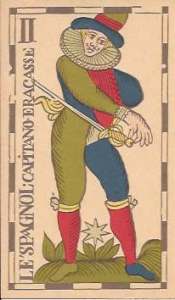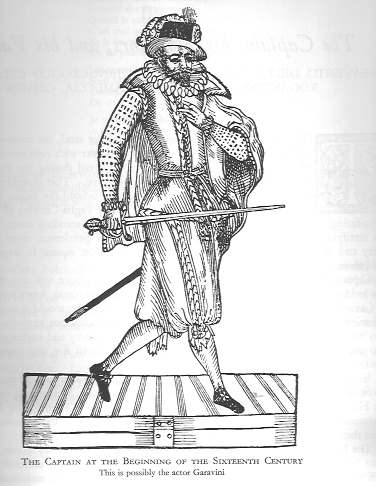The Spanish Captain in the Vandenborre Deck

Question: Who is the Spanish Captain, and what’s he doing in a tarot deck?
The Short Answer: He’s a character from the Commedia dell’Arte who substitutes for the Papesse in a type of 18th-century Belgian deck.
The Long Answer: Read the rest of the article.
What is Commedia dell’Arte?
It’s a type of popular theater with roots in the classical world. It flourished in Renaissance Italy and spread throughout Europe, especially France, in the 14th through 18th centuries. An array of standard characters appeared in every play like Harlequin, Pantalone, and Pulcinella, who was the prototype for Punch and Pierrot. The audience instantly recognized these characters by their masks, their walk, costume and regional accent, as well as characteristic slapstick routines, stage business, gestures, jokes, and favorite curse words.
The plays were improvised from brief sketches. Favorite story lines included thwarted lovers, stolen children, scheming widows, cross-dressing, and mistaken identity. Physical comedy and slapstick carried the action. If an actor ran out of inspiration he could fall back on stock bits of comic business called lazzi that featured chamber pots, bowls of pasta, pig bladders and enemas. Audience members would eagerly anticipate their favorite lazzi.
Who was the Captain?
 He was a bombastic soldier who constantly boasted of his exploits in love and war, but was actually a coward. He would strut and preen in his splendid clothes, challenge rivals to duels, seduce princesses and pretend to be an aristocrat. The Captain was depicted with a huge plumed hat, flowing cape, oversized sword, silly mustache and an affected Castilian accent. His mask had a very long, phallic nose. He had many regional names: Capitain Fracasse (or Ercasse), Spanish Captain, Le Spagnolo Capitano, Capitan Cocodrilo, or Scaramouche. He was the prorotype for Cyrano de Bergerac, Captain Spavento and Ralph Roister Doister.
He was a bombastic soldier who constantly boasted of his exploits in love and war, but was actually a coward. He would strut and preen in his splendid clothes, challenge rivals to duels, seduce princesses and pretend to be an aristocrat. The Captain was depicted with a huge plumed hat, flowing cape, oversized sword, silly mustache and an affected Castilian accent. His mask had a very long, phallic nose. He had many regional names: Capitain Fracasse (or Ercasse), Spanish Captain, Le Spagnolo Capitano, Capitan Cocodrilo, or Scaramouche. He was the prorotype for Cyrano de Bergerac, Captain Spavento and Ralph Roister Doister.
The Captain was originally Italian. The height of his popularity was the 15th and 16th centuries, the age of the condottiere, who were universally despised as they pillaged their way across the countryside. Once Spain got control of most of Europe, the Captain morphed from an arrogant conqueror into a cowardly Castilian, the victim of gratuitous violence and embarrassing mishaps.
Some lazzi associated with the Captain:
- He tries to break up a fight between two armed men. They turn on him and beat him to a pulp.
- The Captain is on one knee serenading a lady under her balcony when a servant accidentally empties a chamber pot on his head.
- A lazzo that has direct bearing on this card: someone describes a beautiful woman to the Captain. The dagger hanging from his belt comes to life, simulating an erection.
The tarot card’s designer was obviously familiar with this last bit of stage business and knew his fellow card players would be too; so he copied the Captain from an engraving and modified the sword handle.
Why a Spanish Captain on a Belgian Deck?
In 1604, Spain seized Belgium and oppressed the people for the next century with heavy taxes and the Spanish Inquisition. When the King of Spain died in 1700, the Bourbons and Hapsburgs fought the War of Spanish Succession from 1700 to 1714, mostly on Belgian soil. The Hapsburgs won and got control of Belgium, which was known as Austrian Belgium until 1795.
In a deck printed by Antoine Jar of Brussels, “Laborne” is printed in large block letters on the Captain’s thigh. Laborne was a Parisian card printer in the very early 18th century, so it’s possible he designed the Spanish Captain card just as Spain was losing its grip on European politics and it was becoming less dangerous to mock the Spanish overlords.
Belgian Decks
 In some places, card makers were ordered to replace the Popesse and Pope with something less controversial, because they were considered either sacrilegious or too Catholic. They were usually replaced with something pagan like Jupiter and Juno or Moorish Kings.
In some places, card makers were ordered to replace the Popesse and Pope with something less controversial, because they were considered either sacrilegious or too Catholic. They were usually replaced with something pagan like Jupiter and Juno or Moorish Kings.
In 18th century Brussels a group of card makers, including Vandenborre, used the Spanish Captain to replace the Papesse, and replaced the Pope with Bacchus astride a wine barrel. The decks that still exist were printed from 1770 to 1790 at end of Austrian rule; but there may be earlier decks that are lost. These nearly identical Belgian-style decks were printed in Brussels and France by various print shops. See them in Stuart Kaplan’s Encyclopedias referenced below.
The Spanish Captain and Bacchus weren’t the only unique cards in Belgian decks. The Tower was called La Foudre (The Thunderbolt) and showed a shepherd under a tree that’s being hit by lightning. The Devil is in profile breathing fire, with faces in his chest, knees, and stomach. The Star card depicts a man seated in front of a tower holding calipers, while The Moon shows a woman holding a spindle. The court cards and other human figures have short, stumpy legs giving them a slightly squashed appearance.
These cards have predecessors in two decks printed in Paris: Jacques Vieville from about1650 and the slightly earlier Anonymous Parisian deck. This unique imagery also appears on 15th century decks from Ferrara, and may be evidence of an alternate tradition that eventually lost out to the standard TdM pattern. The Vandenborre deck, the only facsimile Belgian deck on the market, was published in Belgium by Carta Mundi as the Flemish Tarot (Vandenborre Bacchus Tarot) in 1983.
References
Duchartre, Pierre Louis. The Italian Comedy. New York: Dover Publications,1966. (Originally published by George G. Harrap, 1929).
Dummett, Michael. The Game of Tarot: From Ferrara to Salt Lake City. Duckworth, 1980. p. 204-210.
Gordon, Mel. Lazzi: The Comic Routines of the Commedia dell’Arte. New York: Performing Arts Journal Publications, 1983.
Kaplan, Stuart R., Encyclopedia of Tarot Volumes I, p. 147-152 and Vol. II, p. 320-330. Stamford CT: U.S. Games Systems, Inc., 1978 and 1986.
Olsen, Christina. The Art of Tarot, New York: Abbeville Press, 1995. (Ferrarese and Parisian decks).
www.wopc.co.uk/Belgium/vandenborre-tarot (World of Playing Cards)
Youtube has numerous videos introducing Commedia characters and showing comic routines.
A special thanks to my good friend and tarot colleague Lady Lea who inspired this article when she presented me with two books on the Commedia dell’Arte.


Great post – those are some lovely engravings.
Capitaine Fracasse, a blundering daredevil-type figure, is an image still well known in France. The 19th century novelist Théophile Gauthier wrote an eponymous novel which was very popular at the time.
I always thought it would be a nice idea to have an 80 or 82 card deck, with both pairs of the good Captain, Bacchus, and Jupiter and Juno as stand-ins for our more familiar Pope and Popesse.
Incidentally, some of the classic late 19th century/early 20th century French authors on the occult Tarot disagreed on the replacement of the Pope and Popesse: some thought the substitution for Juno and Jupiter was equivalent or analogous; others thought the symbolism was very different – too different. But, as far as I can recall, I’ve never seen the Capitain or Bacchus explained in terms of divinatory significance: perhaps some readers have leads?
Thanks for the additional information. It never occurred to me that the substitute figures might have been chosen for their divinatory significance. Reading with the Vandenborre deck would certainly put a different twist on one’s divinations. I’d love to hear opinions on whether the substitute cards were deliberately chosen to resonate with the Pope and Popesse they replaced.
If I remember correctly there is a paper probably by Thierry Depaulis, and probably in “Tarot Jeu et Magie” which points the exact iconographic origin of the card.
Regarding the pattern’s name, it should be called “Rouen-Bruxelles” pattern as the “belgian tarot” points to a later pattern, and because the example of Adam de Hautot Deck in Rouen (including Fracasse and Bacchus) predates – as far as I remember – all Belgian examples of this pattern – there was also a paper presented at the latest IPCS convention (to which I alas couldn’t attend) which should shed even more light on this specific pattern and its relation to Vieville deck.
Thank you so much, Bertrand, for this extra information. It looks like I could do much deeper research into this card.
Hi Sherryl and Bertrand,
You are right Bertrand, Thierry Depaulis mentions ‘Le capitaine Fracasse’ as engraved by the French artist Michel Lasne on pages 81 & 82 of his book ‘Tarot, jeu et magie’.
I guess you reffer also to the paper I presented in Turnhout in october 2015. I indeed found 13 cards that I suspect being a (if not thé) link between the Hautot deck and the Belgian tarots.
I am doing more research on Belgian Tarots and will publish the results in time (hopefully soon).
Cheers,
Rafaël